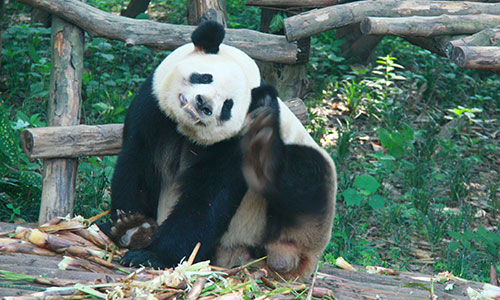Chengdu Research Base of Giant Panda Breeding
Located a few miles out of Chengdu downtown, Chengdu Research Base of Giant Panda Breeding is dedicated to the preservation and protection of the endangered Giant pandas through constant research and breeding. The zoo-like base creates authentic care and setting for this lovely creature, with cozy and comfortable nursery rooms as well as open-air wonderland surrounded by lush green bamboo groves, which boasts one of the best places in China where visitors could witness the national treasure, giant pandas.
Chengdu Panda Base is built as a non-profit world-class institute dedicated to the breeding, research, protection and educational tourism of the endangered giant pandas.
Founded in 1987, the base started with six sick pandas rescued from the wild and now it enjoys the world's largest population of captive giant panda by artificial breeding. The base inhabits over 110 pandas through decades of reproduction, and now it welcomes visitors to get close to this at-risk species, and join the force of giant pandas and their habitats protection.
There are two nursery centers respectively named Sunshine and Moonlight for raising panda babies varying from newborns to 2-year-old ones when they are most active and lovely.
- Sunshine Nursery Center:This center was built into the shape of the sun thus named Sunshine where travelers can see adult pandas, panda cubs as well as panda babies. The famous Panda Kindergarten is also located here where the lovely scene of a group of panda cubs playing outside in their outdoor enclosure.
- Moonlight Nursery Center: Moonlight Nursery Center was built in the shape of the moon where also keep adult pandas, panda cubs and babies.
Difference: The outdoor enclosure in the Moonlight Nursery Center is smaller than the one in Sunshine Nursery Center and there is a greater chance to see panda babies in the Sunshine Nursery Room.
At the open-air playground, a dozen of panda cubs take great pleasure in outdoor activities by rolling over the grassland, eating bamboo shoots, enjoying sunbathe, taking naps, or playing games with their intimate buddies. These cute babies present visitors an impressive panda experience with their eye-catching movements. Along the fence of the enclosures, viewers could not only get delighted in the funny scene of panda's breakfast time, but also become a panda film maker by shooting amazing pictures and videos.

Furthermore, September to November is a special period when most new-born panda babies are born, and visitors gain greater chances to closely observe these little pink creatures in their incubators by the glass windows at the indoor rooms. Usually seven days after their births, the black hair begins to cover their necks and four limbs, so travelers will be very lucky to see the pink ones at the nursery.
No. 1 and No. 2 villas are paradise for adult pandas, where inhabit a lot of super stars exposed to high spot light of the media.
- Xiaohuihui: The panda named Xiaohuihui usually got bullied by other fellows because of its inborn grey hair, but gradually accepted by his families when its furs turn to dark black.
- No. 51: Panda named after the number 51 is also a super hero as he got a weight of 51g at birth, only one third of the weight of other normal newborn panda babies, but he finally survived and grew into a tough man.
- Beichuan: The panda Beichuang enjoys wide popularity on the internet as an uncultivated wild sweetie rescued in an earthquake of her hometown, Beichuan.
- Qizhen: Furthermore, in the panda kingdom spread many legendary stories about the panda Qizhen, a super mom by giving birth twins for four times, and all her children were successfully raised up and became new stars.
The mischievous red pandas also inhabit in the base as the companion animals for giant pandas because they share a lot in common in terms of living habitat and dietary habits. Covered with fluffy reddish-brown hair, they get adorable appearance similar to little coatis. Flexible and vivacious, the cage-free red pandas are excellent climbers and they love hanging out at treetops. Like the giant pandas, they are unable to digest cellulose, so they mainly feed on bamboo, and eat small birds, insects, eggs, mushrooms, flowers and berries sometimes. Having no fear for tourists, the red pandas in captivity are cooperative for taking pictures.
Besides, visitors also get the chances to see various rare birds, such as black-necked cranes, peacocks and egrets, and a variety of butterflies as well as other insects.
The world's only museum focusing on giant pandas is located in the base, which is the best place to have a comprehensive understanding about giant panda’s evolution history, characteristics, life habits, distribution in the wild and current living condition. An array of exhibits including giant panda specimens, pictures, fossils, models and dissected pandas are on display allowing you to learn more about this vulnerable species and the ongoing protection efforts that has been made.
A professional cinema was established for visitors to watch a documentary film The Breeding of Giant Panda both in Chinese and English. You could uncover the little-known secrets of giant pandas by witnessing the whole process of panda breeding, including estrus, mating, pregnancy, delivery and growth. You could enjoy the film at any time between 08:40 and 17:30.
- The base is outfitted with panda cinema and museum to offer visitors more chances to acquire common senses and detailed information about the species in extinction.
- 08:00 – 09:00 in the morning is the best time for a visit when pandas are most active. After 10 am, they may take early afternoon naps indoors because of the higher temperature. And in cold winter, this will not be a problem as giant pandas are good with cool weather but morning is suggested for your visits.
- The eateries inside the base are quite limited, so you are suggested to take some easy-carry snacks and drinks.
- When taking pictures of the pandas, the flashlight is not allowed as their eyes are very sensitive to lights.
- Take the metro line 3 to Panda Avenue Station, and then transfer buses No. D025 or No. 198 to Panda Base directly.
- A taxi ride from Chengdu downtown to Panda base may cost RMB 50 around.









